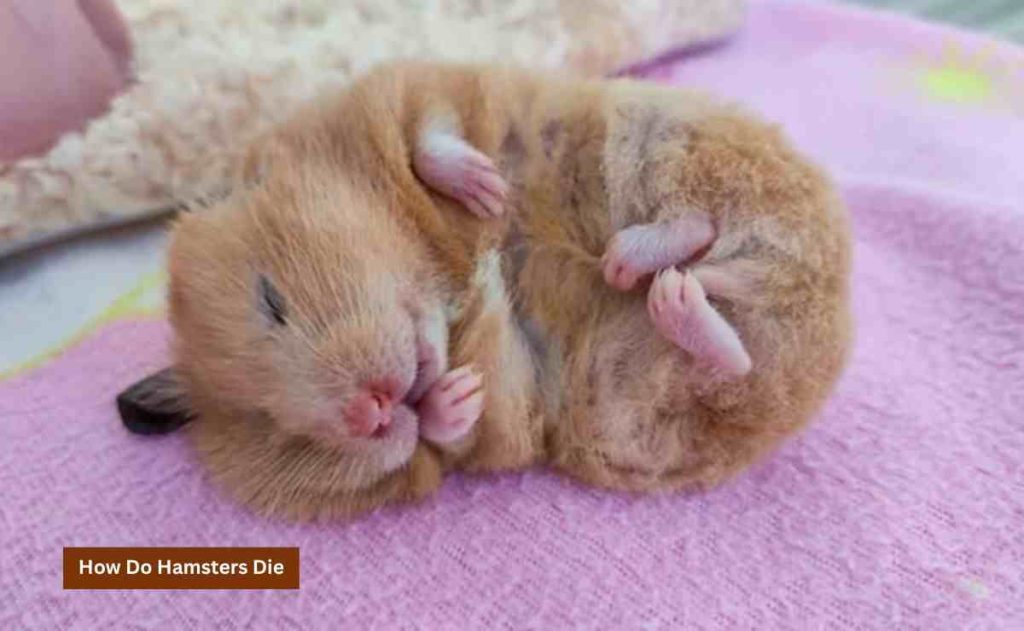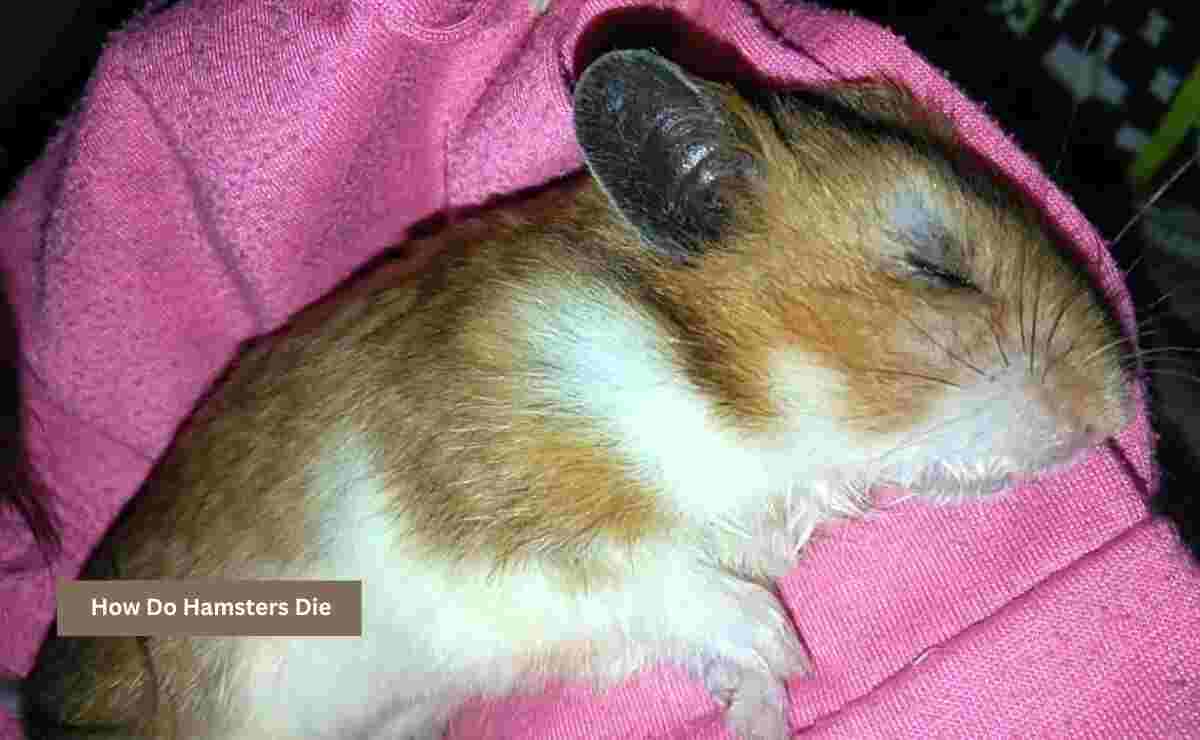It’s a bitter truth that you have to say goodbye to your furry friend. Compared to other pets, hamsters have a shorter lifespan. So as a pet owner, you must know how do hamsters die.
Hamsters can die from a variety of causes. It can be old age, illness, or severe diseases. Their body is too fragile. Sometimes they die early before understanding the signs. Still, you should be aware of the reasons to prevent the unexpected death of a hamster.
How Do Hamsters Die?

Hamsters are adorable small pets but their bodies are so fragile. They are prone to be affected by various diseases. As soon as you detect their disease, it becomes more serious, and die easily. If you find out the disease, treat them, and take care of them, they can live a long and healthy life. Here are some common causes of their death.
1. Old Age
One common cause of hamster death is old age. Though aging is not a disease, you can notice some not-so-good conditions. As hamsters get older, their bodies naturally start to deteriorate, leading to a decrease in overall health and vitality. Signs of old age in hamsters include decreased activity levels, weight loss, and changes in behavior.
Hamsters have an average lifespan of one to three years and a few hamsters hardly can expect to live long. If you adopt an adult hamster, then there is no information on how much time they live. It is important to provide older hamsters with extra care and regular visits to a veterinarian to monitor their health and provide any necessary medical treatment.
2. Bad Gens
Hamsters with bad genes face a higher risk of premature death due to inherent genetic vulnerabilities. Hamsters born in pet mills lack proper care and have unselected parents, making them more prone to genetic diseases, weakened immunity, and fatal infections.
Hybrid hamsters from unethical breeding might carry hereditary diseases like Polymyopathy and Cardiomyopathy, impacting their health and shortening their lifespan.
Hamsters from passionate breeders have healthier genes, born from carefully selected parents without hereditary diseases. This results in a longer, healthier life.
3. Stress
Stress isn’t a disease itself, but it creates conditions that negatively affect your hamster’s immune system. Then it becomes more susceptible to illnesses. The bacterium Clostridium piliforme, opportunistic in stressed hamsters, poses a particular threat.
Stress has the power to worsen existing health issues, such as heart disease. Many cases of unexpected hamster deaths, attributed to heart attacks or strokes, are often connected to acute or chronic stress. This stress-induced outcome also aligns with normal age-related deaths.
4. Rough Handling
Improper handling can contribute to hamster mortality. Hamsters are delicate animals and can easily become injured if not handled correctly. As Hamsters like solitary, rough handling and sudden changes in the environment can cause a hamster to become anxious or frightened, leading to health issues or even death.
Hamsters also can die if they fall from a great height, sometimes some falls kill them on the spot. It is important to handle hamsters gently and provide them with a quiet and stress-free environment to minimize the risk of death.
5. Wet Tail
“Wet tail” means diarrhea in hamsters. It goes by other names like proliferative ileitis, regional enteritis, and hamster enteritis. This condition is prevalent among hamsters, particularly the golden hamster, and is recognized as one of the most common spontaneous diseases.
Wet tail in young hamsters (3–10 weeks old) is often linked to an infection by the bacterium Lawsonia intracellularis. In adult hamsters, various bacteria, including Clostridium difficile, Escherichia coli, Proteus morganii, and Clostridium piliforme (associated with Tyzzer disease), are implicated.
Dehydration is a common symptom. Additional signs are weight loss, anorexia, a messy coat, lethargy, and a hunched posture. Stress acts as a contributing factor to the development of this disease.
Survivors of wet tails face complications, including complete or partial obstruction of the ileum. Unfortunately, wet tail has a high mortality rate, reaching up to 90%, and death often occurs within 24–48 hours after symptoms first appear.
6. Excessive Heat
Hamsters are susceptible to heat-related issues, and heat stroke is a real concern. The ideal temperature for a hamster ranges from 75°F to 80°F (24°-27°C). Excessive heat can lead to blood thickening, disrupting normal organ function and resulting in organ failure, ultimately leading to death if not addressed promptly.
When temperatures soar, you should take care to prevent heat-related complications. Provide a cool environment and proper hydration which is essential for their survival.
While cold temperatures don’t usually kill hamsters, they can induce hibernation. It’s crucial to recognize the signs and know how to gradually warm up your hamster, offering calorific food or drink to bring them out of this torpid state.
7. Pneumonia
Pneumonia is an infection of the lungs that is one of the most potentially lethal diseases in hamsters. This is the second most common fatal disease in hamsters. It is caused by bacteria like Diplococcus sp, Pasteurella pneumotropica, Streptococcus sp., and Staphylococci sp. The Sendai virus has also been identified as a cause of pneumonia in hamsters.
Pneumonia can swiftly become deadly, especially if your hamsters go through stress factors like sudden temperature changes. To identify the disease, watch for symptoms such as mucus discharge, difficulty breathing, constant sneezing, and a noticeable change in behavior, including depression.
8. Cancer
Cancer is also known as neoplasia. Some certain areas are more prone to affect like the gastrointestinal tract, haematopoietic system, skin, and appendages. Lymphoma is the most reported cancer that often affects the haematopoietic system. You can see symptoms like anorexia, alopecia, and weight loss due to this cancer.
Skin melanomas are frequently reported, with a notable prevalence in male hamsters. These tumors occur on the skin and contribute to the spectrum of neoplastic diseases observed in hamsters.
Djungarian (winter white) hamsters are more prone to being affected of neoplastic disease compared to Syrian hamsters. The majority of tumors in Djungarian hamsters are integumental in nature. Cancer is a rare disease in hamsters than other animals, such as rats, domestic fowl, and mice strains.
9. Kidney Disease
Kidney disease is specifically degenerative renal disease which tends to affect older female hamsters. Amyloid deposition formation is observed as a significant symptom in this renal deterioration.
Dietary factors play a role in hamster kidney health. Evidence suggests a potential link between a higher protein diet and the increased chances of nephritis. Hamsters on a 12% protein diet maintained comparable body size to those on diets with 18% and 24% protein and exhibited a lower incidence of nephritis.
10. Diabetes
Diabetes in hamsters involves abnormal blood sugar levels due to insufficient insulin production or ineffective use. You should look for specific symptoms like increased thirst, excessive drinking and urination, weight loss, lethargy, and the presence of strong-smelling urine. Recognizing these signs promptly is essential for early intervention and care.
Managing hamster diabetes may involve a special diet. This dietary approach can potentially extend the lives of hamsters with diabetes. The importance of a nutritious diet becomes a crucial element in the overall care of hamsters dealing with this metabolic challenge.
11. Bad Diet
The lifespan of your hamster is significantly influenced by two critical factors: diet and stress. Relying solely on pellets for your hamster’s diet is inadequate. Hamsters require a diverse array of foods, including seeds, dry and fresh vegetables, herbs, flowers, and protein sources like mealworms and crickets. This comprehensive diet fulfills their nutritional needs and contributes to overall well-being.
Certain foods are outright dangerous for hamsters. These include chocolate, milk, peanut butter, honey, garlic, onion, citrus fruits, parsley, celery, curly lettuce, beans, and frozen vegetables. Feeding fatty or raw meat to your hamsters can lead to serious consequences. Avoiding these risky food items is essential for the health and safety of your hamster.
12. A bad enclosure
A hamster’s enclosure isn’t just a home; it’s a pivotal factor in their healthy life. Their cage should be a minimum of 1000 square inches which offers ample floor space.
Inadequate space and lack of enrichment can lead to severe consequences. Stress, obesity, and heart diseases can quickly emerge, posing a substantial threat to your hamster’s health and potentially leading to a premature demise.
Neglecting enclosure hygiene is a cause of indirect risks. Sound pollution, olfactory disturbances, and continuous exposure to artificial light are all factors that can contribute to incurable and fatal hamster diseases.
A hamster’s natural instincts crave exploration and activity. Beyond the enclosure, hamsters need dedicated playtime and interaction. Hamsters benefit greatly from regular outings in playpens, hamster-proof rooms, and scheduled interaction.
Signs of Hamsters Illness
Hamsters are masters of hiding their illness. But it’s your responsibility to observe their behavior. So here are the red flags of their illness:
- Reduced activity, especially in a hamster still in its prime, can signal advanced illness.
- While older hamsters naturally sleep more, this change in sleeping patterns can also be indicative of illness.
- A disheveled or poorly groomed coat can suggest distress.
- Changes in eating habits, such as a loss of appetite, may be a sign of underlying health issues.
- Alterations in feces, like consistency or frequency, should not be overlooked.
- Any change in breathing patterns, such as rapid or labored breathing, should be taken seriously.
- Abnormal water intake or urination patterns can be a sign of an underlying problem.
- Regularly weighing your older hamster can help monitor weight changes, which may indicate health issues.
- Overly frequent grooming can be a sign of discomfort or distress.
Final Words
The exact cause of a hamster’s death varies, but you need to understand the potential factors to prevent their premature death.
By providing hamsters with appropriate veterinary care, a safe living environment, and proper handling, owners can help maximize the lifespan and overall health of these small and beloved pets.
